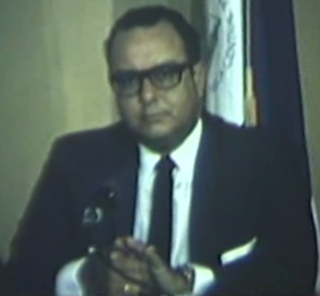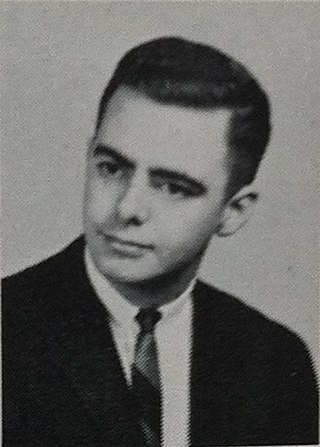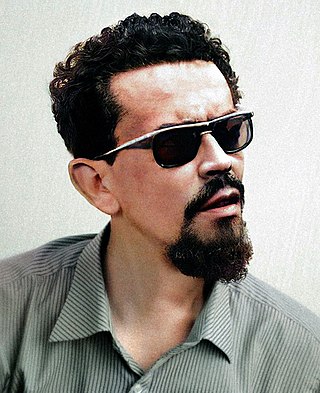
In the history of Nicaragua, the Contras were the right-wing militias who waged anti-communist guerilla warfare (1979–1990) against the Marxist régime of the Sandinista National Liberation Front and the government of the Junta of National Reconstruction, which assumed power after the Nicaraguan Revolution in 1979. Moreover, by 1987, the CIA had organized most of the Contra militias into the anti-communist Nicaraguan Resistance, wherein the Nicaraguan Democratic Force (FDN) was the greatest militia.
Nicaragua is a nation in Central America. It is located about midway between Mexico and Colombia, bordered by Honduras to the north and Costa Rica to the south. Nicaragua ranges from the Caribbean Sea on the nation's east coast, and the Pacific Ocean bordering the west. Nicaragua also possesses a series of islands and cays located in the Caribbean Sea.

The Sandinista National Liberation Front is a Christian socialist political party in Nicaragua. Its members are called Sandinistas in both English and Spanish. The party is named after Augusto César Sandino, who led the Nicaraguan resistance against the United States occupation of Nicaragua in the 1930s.

Anastasio "Tachito" Somoza Debayle was the 53rd President of Nicaragua from 1967 to 1972 and again from 1974 to 1979. As head of the National Guard, he was de facto ruler of the country between 1967 and 1979, even during the period when he was not the de jure ruler.

Augusto César Sandino, full name Augusto Nicolás Calderón Sandino, was a Nicaraguan revolutionary and leader of a rebellion between 1927 and 1933 against the United States occupation of Nicaragua. Despite being referred to as a "bandit" by the United States government, his exploits made him a hero throughout much of Latin America, where he became a symbol of resistance to American imperialism. Sandino drew units of the United States Marine Corps into an undeclared guerrilla war. The United States troops withdrew from the country in 1933 after overseeing the election and inauguration of President Juan Bautista Sacasa, who had returned from exile.
Edén Atanacio Pastora Gómez was a Nicaraguan politician and guerrilla who ran for president as the candidate of the Alternative for Change (AC) party in the 2006 general elections. In the years prior to the fall of the Somoza regime, Pastora was the leader of the Southern Front, the largest militia in southern Nicaragua, second only to the FSLN in the north. Pastora was nicknamed Comandante Cero.

The Nicaraguan Revolution began with rising opposition to the Somoza dictatorship in the 1960s and 1970s, the ouster of the dictatorship in 1978–79, and fighting between the government and the Contras from 1981 to 1990. The revolution revealed the country as one of the major proxy war battlegrounds of the Cold War.

William D. Stewart was an American journalist with ABC News who was murdered by Nicaraguan government National Guard ("Guardia") forces while reporting on the Nicaraguan Revolution as Sandinista rebel forces were closing in on the capital city of Managua in 1979. Footage of his execution was repeatedly broadcast on network television, resulting in an uproar in the United States against the Somoza regime.
The NicaraguanNational Guard was a militia and a gendarmerie created in 1925 during the occupation of Nicaragua by the United States. It became notorious for human rights abuses and corruption under the regime of the Somoza family (1936–1979). The National Guard was disbanded when the Sandinistas came to power in 1979.
Operation PBFortune, also known as Operation Fortune, was a covert United States operation to overthrow the democratically elected Guatemalan President Jacobo Árbenz in 1952. The operation was authorized by U.S. President Harry Truman and planned by the Central Intelligence Agency. The United Fruit Company had lobbied intensively for the overthrow because land reform initiated by Árbenz threatened its economic interests. The US also feared that the government of Árbenz was being influenced by communists.

Carlos Fonseca Amador was a Nicaraguan professor, politician, writer and revolutionary who was one of the founders of the Sandinista National Liberation Front (FSLN). Fonseca was later killed in the mountains of the Zelaya Department, Nicaragua, three years before the FSLN took power. He has posthumously received the titles of National Hero of Nicaragua and Commander in Chief of the Sandinista Popular Revolution.
La Prensa is a Nicaraguan newspaper, with offices in the capital Managua. Its current daily circulation is placed at 42,000. Founded in 1926, in 1932 it was bought by Pedro Joaquín Chamorro Zelaya, who had become editor-in-chief. He promoted the Conservative Party of Nicaragua and became a voice of opposition to Juan Bautista Sacasa, for which the paper was censored. He continued to be critical of dictator Anastasio Somoza García, who came to power in a coup d'état.

Joanna Cassidy is an American actress and former model. She began working as a model in the 1960s and made her professional acting debut in 1973, appearing in the thriller films The Laughing Policeman and The Outfit. She later starred in films Bank Shot (1974), The Late Show (1977) and went to star in the short-lived television series The Roller Girls (1978) and 240-Robert (1979). In 1982, she played replicant Zhora Salome in science fiction film Blade Runner.

Adolfo Calero Portocarrero was a Nicaraguan businessman and the leader of the Nicaraguan Democratic Force, the largest rebel group of the Contras, opposing the Sandinista government.
Fernando Chamorro Rappaccioli, known as "El Negro" ("Blackie") for his dark complexion, was a longtime Nicaraguan rebel fighting both the Somoza and Sandinista regimes. Efforts to build a Contra Southern Front around him played a part in the Iran–Contra affair.

Alsino and the Condor is a 1982 Nicaraguan film directed by Chilean filmmaker Miguel Littín. It was nominated for the Academy Award for Best Foreign Language Film. It won the Golden Prize at the 13th Moscow International Film Festival. The film was a co-production between Nicaragua, Mexico and Cuba. The film is loosely based on the novel Alsino by Chilean writer Pedro Prado, and is set during the Nicaraguan Revolution. It starred Dean Stockwell.
In 1979, the Sandinista National Liberation Front (FSLN) overthrew Anastasio Somoza Debayle, ending the Somoza dynasty, and established a revolutionary government in Nicaragua. Following their seizure of power, the Sandinistas ruled the country first as part of a Junta of National Reconstruction. Following the resignation of centrist members from this Junta, the FSLN took exclusive power in March 1981.
The Calderonista Invasion of Costa Rica was a small rebellion carried out in North-West Costa Rica by forces loyal to the disgruntled former president Rafael Calderón, and was supported by the Government of Nicaragua who were unhappy with the election of Jose "Pepe" Figueres Ferrer to the Costa Rican Presidency two years prior.

José Trinidad Muñoz was a Nicaraguan military general who served as the de facto military leader of Nicaragua in 1845, and again from 1847 to 1855, preceded by Casto Fonseca.











